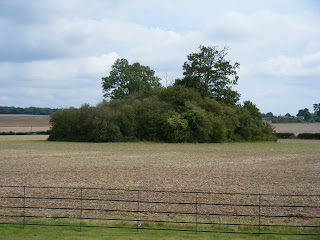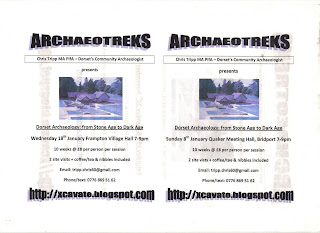Community Archaeology blog; adult education; walks and talks; school visits.
Friday, 30 December 2011
Archaeology courses for January
Just a quick post to remind local people that they can sign up for a great 10 week course on 'Dorset Archaeology' at Bridport and Frampton (Dorchester). Starting the 8th and 18th of January.
Monday, 26 December 2011
Dorset Cursus
Hope to see you at the Dorset Cursus (the soil mark on the left-the other feature is a long barrow) on January the 8th at 10am. Meet up at the church at Gussage St Michael.
Change of walk
The walk on the 22nd of January will now be at Oakley Down barrow cemetery and not Bincombe. This is an impressive site and I will be posting more details nearer the day.
All the best for 2012 - Happy New Year.
Thursday, 15 December 2011
Artefacts - just 'stuff'?
This is a little video I did some time ago which explains my take on why artefacts are meaningful to me. What would an ancient aretfact mean to you if you found one?
Tuesday, 13 December 2011
January Walks list
Monday, 12 December 2011
Boats in the Bronze Age - never!
 |
| Diggers at work on a boat |
As with many other aspects of the media everything has to be definitive. So, according to most reports, the finding of several intact boats on the River Nene in East Anglia means that it "provides possibly the most detailed view yet of what life was like 3,000 years ago". This is after the last 'most detailed view' and before the next 'most detailed view'. They even used wooden cutlery! Who would have guessed. This is a very rare and significant find, but it is just one more piece in the infinitely complex fabric of human development over the last 3 million years.
 |
| One of the boats post excavation |
The survival of wooden artefacts depends on them being in anaerobic conditions since they were deposited, thus microbes cannot set off the decay process. Usually you may be lucky to find a few small items or even parts of human beings (as in the 'bog bodies'). To find 6 boats is quite remarkable. They range from 2-8 metres in length and as with other examples they were made by hollowing out the trunk of a tree, in this case oak. Some of these boats have been decorated.
 |
| Digging quite deep |
There is some indication that the weapons are similar to Spanish ones. It is no surprise that these Bronze Age people has extensive trading contacts with the south and the Med generally. Such links had been established for many centuries. Again the newspapers stated: "It (the finds) also indicates people were more mobile than previously thought". Not really. Archaeologists have known for some time that trade was international since the Stone Ages.
It is great that the diggers have possibly located the settlement associated with the boat site. This is the real significant find and would link in the living space with the 'port' that they would have used to travel and trade from. Also the finding of eel traps similar in design to those still used today underlines the old adage that 'if it is not broken don't fix it'.
 |
| Keeping a boat wet until removal |
So, it is a good thing to have archaeology in the news but always take what is reported with a 'pinch of salt' and wait for the archaeologists report.
Sunday, 11 December 2011
The lady of Villers-Carbonnel
You may have seen reports of this stunning figurine found in France and described as a 'fertility goddess' and 'earth mother'. Amongst archaeologists this is still hotly debated, with some 'leading' figures insisting that they are representations of ancestors (see past posts here). As you can see this clay figure resembles many such creations of a similar nature that were made not just c.6,000 years ago, as in this 8 inch high example from the Neolithic, but tens of thousands of years ago from the Palaeolithic. What is unusual is to find one so far north.
She was found on the River Somme in several bits and still in situ in a kiln. With an emphasis on the thighs and buttocks it follows the same pattern as many other examples of female figurines and is very stylised in other aspects, with no facial features or attempts at trying to make it look like a real human being. That is because she wasn't. In the papers she is called a 'cult' figure but there is evidence that a female dominated religion was widespread during the vast time period before the Indo-Europeans spread into the continent in the Bronze Age. To call this a cult is ridiculous.
The find was as a result of constructing a 60 mile long and 50m wide canal to allow barges to link the Seine and Rhine to Belgium ports, with the French government's 'Inrap' agency given funds to explore the possible 77 sites to be uncovered. Wouldn't happen here, as we have a private dominated archaeology culture overseen by government 'quangos'. Which is the best....?
Tuesday, 6 December 2011
London visit
 |
| The site today |
I returned to my old home in Lewisham this weekend, also to see my grandsons in Essex and spend some time in Greenwich. When I was working for the Museum of London Archaeology Service from 1998 to 2002 the Channel 4 programme Time Team had a dig in Greenwich Park to see if they could confirm the site of a villa uncovered in 1902 during routine works. In that year they found three floors, one tessellated (made of clay squares), some fragments of inscribed stone, painted wall plaster, the right arm of a life-sized limestone statue, pottery, including decorated samien and 300+ coins of the 1st-5th centuries.
During the felling of some elm trees in 1978/9 further finds included evidence of a metaled floor surface to the south of a buildings wall.
In 1999 Time Team, with the help of MoLAS and Birkbeck University, found that this site was that of a temple not a villa. Evidence included a tile fragment stamped with the initials of the 'Procurator of the Province of Britain in London', the chief financial agent of the Emperor and only found on public buildings. A marble inscription was dedicated to the spirits of the Emperors and the god Jupiter with part of the dedicators name, probably Maecilius Fuscus, Imperial Governor of Britain in the mid-3rd century AD. 101 coins were also found of the 3rd to 4th centuries, more painted plaster, animal bones, probably sacrifices and more buildings to the immediate east of the original mound on which the temple stood.
 |
| Maiden Castle temple |
Romano-British temples were used for healing, pilgrimage, worship and offerings to the gods. This site was near to the main road from Kent into London, Watling Street, so was probably not only used by locals but also travellers.
During filming a seasoned digger, who had worked for MoLAS for many years, found the inscribed stone and tile fragments and thrown them on the spoil heap! He thought they were part of an old drain!! Luckily a Roman expert saw them and they were recovered. He had to re-enact this senario several times until the film crew were satisfied and then had the added indignity of knowing that it would be shown on national television. Needless to say he was mercifully ribbed about this for some time. Even ol' lags make mistakes.
Thursday, 1 December 2011
Thanks
 |
| Thanks from me |
I would just like to thank all of you (local, national and international) for looking in at my blog. November was the best yet in terms of numbers and I hope that December will beat that. I am looking forward to 2012 to do more walking and visiting archaeological sites, some in the east of the county for the first time. I will be teaching courses on Dorset Archaeology and establishing the weekend Archaeotreks weekends too. All will be reported on here, with pictures and videos. Please leave any comments and hope to see some of you this month and into 2012.
Subscribe to:
Comments (Atom)






